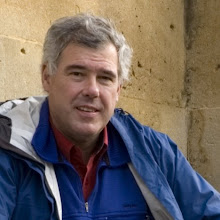
Honoring America’s World War I Heroes
The Rolling W of the 89th Division was on the move again in the Saint Mihiel Salient. It had rained all night and at 4:00 AM when I gazed out my hotel room window into the pitch black it was still raining. Inwardly, I was pleased because 90 years ago it was also raining and I could walk in at least the same weather conditions. But, oh, it did look nasty out there.
I drove the back roads to the village of Limey, where Granddad and his 353rd Infantry Regiment where when the offensive began. I parked by the side of the road next to an old stonewall and for awhile sat in the car and watched it rain. Then I finally told myself, “Come on, we’re here to do this. Let’s get going!”
Before I swung on my backpack, I fitted a small American flag into a loop on the outside on my pack, so it could be seen as I walked. Then I started out into the rain and the dim, pre-dawn light. After I crested the first ridge, I was filled with confidence and surveyed the gentle, rolling landscape around me. “How peaceful and serene,” I thought, “but 90 years ago this was hell on earth.
Granddad had to have passed the ridge-top somewhere near where I stood and John Hunter Wickersham must have already been killed by enemy fire. History was whirling all around me. I plodded on. The 20-km walk was emotional and introspective but also exciting and near the end certainly challenging, but no one was shooting at me. I remember as I was pulling a hill near the end I said to myself, “Ok, Granddad I could sure use a little help now."
I stayed to the country roads and stayed within the general path where my Grandfather and his regiment must have gone through. It was also lonely; many cars zoomed by without even slowing down as they passed by. But, one young man on a motorcycle beeped his horn and waved, which made me feel good.
As I made my way through the town of Thaiucourt, which was liberated by the 89th Division, I stopped and made a self-portrait at the monument pictured in the previous post. Then from there I had one long, gentle hill to go to reach the American Saint Mihiel Cemetery.
As I made that last stretch, I felt great joy and a sense of accomplishment. I had done it. After months of planning and all the background work, I had made my goal a reality. Soon I was through the cemetery gates, but I had one more important thing to do. This historic pilgrimage was not over yet.
I walked through the cemetery with the white crosses and Stars of David all around me. I stopped at the grave of John Hunter Wickersham, 89th Division, 353rd Infantry Regiment, Medal Of Honor. I swung the pack off my back and set it on the freshly cut grass. Then I pulled the out the American Flag from the outside of the pack and on bended knee placed it at the base of the cross and thanked Mr. Wickersham and all those brave men around me for perpetuating freedom and what they did for our great country.
Yes, John Hunter Wickersham and my Grandfather were in the same Infantry Regiment, but they were also both from Denver. So, there is a good chance they knew each other.
The photos are arranged from the beginning of the walk (top) to John Hunter Wickersham’s grave.





























